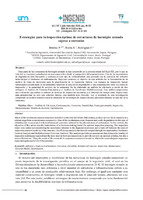Estrategias para la inspección óptima de estructuras de hormigón armado sujetas a corrosión
Date
2021-02-08Author
Benítez Mongelós, Pablo Daniel
Rocha, Eugenio
Rodrigues, Maria Fernanda
Metadata
Show full item recordAbstract
Gran parte de la estructura de hormigón armado se han construido en la primera mitad del Siglo XX,porloque su vida útil se encuentra actualmente en una etapa crítica desde la perspectiva del mantenimiento.Uno de los mecanismos de degradación más frecuentes y costosos en este tipo de infraestructura está asociado con la corrosión del refuerzo inducida por el fenómeno de carbonatación. Bajo este contexto,el objetivo de este artículo fue la formulación de un modelo de toma de decisiones para la planificación de la inspección óptima. Los tiempos de inspección fueron optimizados considerando la incertidumbre inherente al proceso de degradación y una compensación entre los costos de inspección y la capacidad de servicio de la estructura. Se ha elaborado un análisis de eficiencia través de dos enfoques: el Análisis de Frontera Estocástica y el Análisis de envolvente multidireccional. Este análisis proporciona una evaluación que reduce el número de técnicas de inspección necesarias y el intervalo de tiempo entre inspecciones para proporcionarnos una solución óptima, sino también más eficiente. Así, el resultado de esta investigación comprende un modelo numérico para la obtención de los tiempos de inspección más adecuados durante la vida útil de la estructura. Much of the reinforced concrete structures were built in the first half of the 20th century, so their service life is currently at a critical stage from a maintenance perspective. One of the mechanisms more frequent and costly degradation in this type of infrastructure is associated with reinforcement corrosion induced by the phenomenon of carbonation. In this context, the objective of this article was the formulation of a Decision-making model for optimal inspection planning. The inspection times were optimized considering the uncertainty inherent in the degradation process and a trade-off between the costs of inspection and serviceability of the structure. An efficiency analysis has been developed through two approaches: Stochastic Frontier Analysis and Multidirectional Envelope Analysis. This analysis provides an assessment that reduces the number of inspection techniques required and the time interval between inspections to provide not only an optimal solution, but also a more efficient one. Thus, the result of this research It comprises a numerical model to obtain the most adequate inspection times during the useful life of the structure.
URI
info:eu-repo/semantics/altIdentifier/url/https://revistas.fio.unam.edu.ar/index.php/masingenio/article/view/201/541https://hdl.handle.net/20.500.12219/3241
Collections
- Revista +INGENIO [53]
The following license files are associated with this item:




